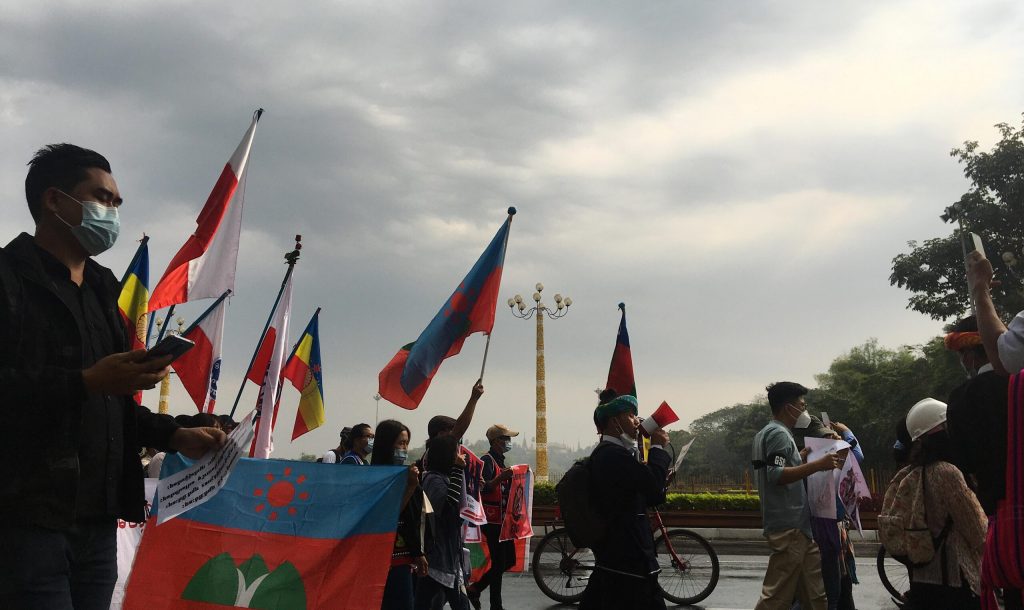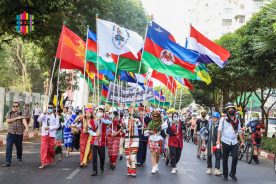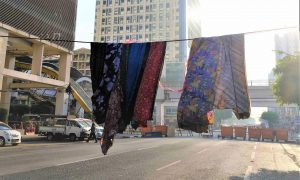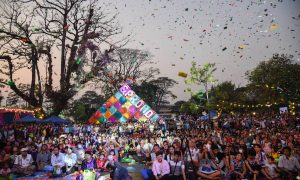As Myanmar’s anti-coup protests persist, there has been an outpouring of stories on the ‘unprecedented unity’ between the diverse ethno-religious groups. Certainly, this unity should not be regarded as ‘unprecedented’, with the 1988 pro-democracy protests and 2007 Saffron Revolution as well-worn precedents that vividly demonstrated the solidarity among members of different religions, ethnicities and age groups.
Nonetheless, this coup has thrown light on a different kind of solidarity that we have yet to see in recent years, especially in a time of escalating mistrust between Buddhists and Muslims, ethnic groups and the Aung San Suu Kyi (ASSK) government in light of the 2017 Rohingya crisis. This solidarity that we are witnessing is different from previous popular uprisings in at least two ways: the geographical scale of the protests propelled by greater digital connectivity; and the nascent empathy towards the predicament of ethno-religious minorities among the Bamar majority. What would these nascent solidarities mean for the future of ethno-religious minorities, who have long been treated as ‘second-class citizens’, in a post-coup Myanmar?
Different geographies of protests
Unlike Buddhist monks who have a long history of activism in Myanmar, minority ethno-religious groups have been much more reticent to engage in political activities. Due to their longstanding vulnerability in the country, most members of minority ethno-religious communities, save for some ethnic armed unions, sought to remain as what Jangai Jap described as ‘neutral bystanders’. According to Jap, this is largely because ‘they see merit in collaborating with whoever is in power’.
In the early days of the coup, ethnic minority elites have reportedly cautioned their members against participating in democracy movements. They emphasised that the coup is primarily a ‘Bamar power struggle between the military and the National League for Democracy (NLD)’, something that ethno-religious minorities should not involve themselves with, for fear of getting on the wrong side of power.
However, youth members of the minority ethno-religious communities have become among the most visible protestors of the Civil Disobedience Movement (CDM) in the wake of the coup. As compared to the previous uprisings that largely unfolded in an era of social media vacuum, this coup is touted as ‘digital warfare’. This expanded digital connectedness among street protestors has significant implications on the solidarity in Myanmar in recent years. In the wake of the coup, military-sanctioned internet blackouts were imposed in the country where over 22 million people –– or 40 per cent of the population –– rely on Facebook as a primary source of communication and information. Responding to the increasingly frequent cyber crackdowns, people attempted to navigate new waters by migrating to platforms offering additional privacy through end-to-end encryption such as WhatsApp, and using virtual private networks (VPNs).
Despite most clergy’s initial reluctance, minority ethno-religious communities across the country, facilitated by greater access to live updates of the coup, came out in force to join the CDM. In their rally, minority ethno-religious participants display placards, flags and banners in their traditional garb to publicly express their identity. The first anti-coup demonstration in Yangon on 6 February was led by two young female activists marching in shirts associated with the Karen ethnic group. Although they are not NLD supporters, they are fervent critics of the military government who have participated in previous campaigns against the military’s brutal treatment of Rohingya Muslims and have been linked to the Kachin and Karen struggles.
As the protests persist, some Rohingyas even displayed signs identifying themselves as Rohingya in Burman Buddhist-majority Yangon. Given the antagonism that publicly identified Rohingya would likely encounter in Buddhist-majority areas, their active presence in the CDM is something which, in the past, would have been regarded as extremely controversial.
The recent weeks of the coup saw street protests expanding from the political hubs of Yangon and Mandalay to ethnic states with a large non-Bamar Buddhist population, including the most far-flung border states such as Shan state. Overseas, Chin Christian refugees showed solidarity by holding anti-military protests on the streets of New Delhi, exhorting for Indian Prime Minister Nadrendra Modi to put pressure on Myanmar’s military government to restore democracy. In Bangladesh’s Cox’s Bazar district which houses the world’s largest refugee camp, Rohingya refugees also started sharing anti-coup messages on social media. Considering their historical ambivalence to engaging in political activities, ethno-religious minorities’ efforts at expanding anti-coup protests beyond the borders of Myanmar is a striking demonstration of their resilience in claiming their stake in rewriting the country’s 2008 constitution to international audiences.
We the People
Bolstering the minorities’ fight for a more just Myanmar is a growing number of vocal Bamar people pledging solidarity with persecuted ethno-religious minorities such as the Rohingyas. On social media and in street protests in recent weeks, a small group of Bamar people expressed public apologies for their past indifference to the military’s role in the Rohingya crisis. They demonstrated alongside the Kachins with signs reading ‘We support Kachin Independence Army.’ An anonymous Bamar female activist explained in an interview with the Transnational Institute, “We are not even experiencing the brutality of the military yet in the cities, like those people in Rakhine experienced every day and every night. Those in Kachin. Those in Karen. Those in Shan. Now we too have to defend ourselves.”
Myanmar’s coup from the eyes of ethnic minorities
Members of ethnic minorities standing against the military are concentrating on institutional change, while majority Bamar NLD supporters focus on the release of party leaders and the formation of government.
Now that these diverse groups are coming together in their shared goal of building a more just Myanmar, new solidarities are beginning to emerge amidst the chaos. But some critics have cautioned against over-romanticising these solidarities. They argued that in a country where being a Burmese citizen is wedded to a particular vision of ethno-religious identity, the revered position of Buddhism will most likely remain unchanged in a post-coup Myanmar.
And yet, how could such fleeting moments of solidarities be fruitfully sustained beyond the confined space-time of the protests? Would this protest be a turning point in paving the way towards a more peaceful Myanmar, a future where the rights of all ethno-religious groups are respected equally?
Even though the recent military crackdowns on the CDM have asserted the unparalleled authority of the Tatmadaw, we must still take heart that this coup has inadvertently offered a glimpse into how a more just Myanmar could look like, albeit at the expense of hundreds of civilian lives. As Rakhine activist Kyaw Hsan Hlaing says: “The current upheaval is devastating, but it also offers a great opportunity. As we join together in opposing military rule, we must also unite under a positive vision that values the rights of all. It is a critical moment in our history, and it must not be squandered.”
Indeed, a huge part of this positive vision falls on the shoulders of young people, who have been game-changers in Myanmar’s history of popular uprisings. With more Bamar youth eager to make amends for the past injustices, their valiant expression of solidarity with persecuted minorities shows that hope to bring about systematic changes in Myanmar is not lost.
While Myanmar’s road to democracy may be long and winding like a meandering river, the river will eventually reach the ocean. With this renewed solidarity in a country long riven by ethno-religious divides, it is with the hope that the ongoing protests will bring the people of Myanmar closer to a more peaceful future.
 Facebook
Facebook  Twitter
Twitter  Soundcloud
Soundcloud  Youtube
Youtube  Rss
Rss 



